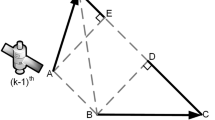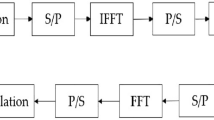Abstract
In this paper, we considered a distributed antenna system (DAS) to expand the coverage of VHF maritime communication systems and analyzed its performances. To reflect the geometrical distributed antenna port placements along the coastline, we considered a linear antenna layout. By deriving the lower bounds of the expected signal-to-noise ratio (SNR), we analyzed the SNR performances for both single-ship and multiple-ship transmission schemes. Next, based on the analytical results, we present design guidelines to implement the DAS based VHF maritime communication system. From the simulation results, the coverage expansion effect of the DAS was verified by the increased expected SNR. In addition, we confirmed that the system design parameters could be found from simple numerical calculations.




Similar content being viewed by others
Notes
Typical value of path loss exponent \(\beta\) in an urban or suburban environment is greater than 3.5; however, due to the smaller propagation loss \(\beta\) in a seaport area, it is closer to 2 [10].
156.8 [MHz], i.e., VHF Channel 16, is used as a marine VHF radio frequency for an international distress call.
1 nautical mile is 1852 m
References
Liaison note to ITU-R working party 5B: Regarding the preliminary draft new recommendation ITU-R M.[VDES]. (2015).
Rec. ITU-R M.1842-1, Characteristics of VHF Radio Systems and Equipment for the Exchange of Data and Electronic Mail in the Maritime Mobile Service RR Appendix 18 channels. (2009).
Roh, W., & Paulaj, A. (2002). Outage performance of the distributed antenna systems in a composite fading channel. In Proceedings of IEEE VTC (pp. 1520–1524).
Wang, D., You, X., Wang, J., Wang, Y., & Hou, X. (2008). Spectral efficiency of distributed MIMO cellular systems in a composite fading channel. Proceedings of ICC, 52, 1259–1264.
Choi, W., & Andrews, J. G. (2007). Downlink performance and capacity of distributed antenna systems in a multicell environment. IEEE Transactions on Wireless Communications, 6, 69–73.
Lee, S., Moon, S., Kim, J., & Lee, I. (2012). Capacity analysis of distributed antenna systems in a composite fading channel. IEEE Transactions on Wireless Communications, 11, 1076–1086.
Gan, J., Li, Y., Zhou, S., & Wang, J. (2007). On sum rate of multi-user distributed antenna system with circular antenna layout. In Proceedings of IEEE VTC (pp. 596–600).
Park, E., Lee, S., & Lee, I. (2012). Antenna placement optimization for distributed antenna systems. IEEE Transactions on Wireless Communications, 11, 2468–2477.
Tang, C., Kandeepan, S., Hourani, A., Munari, A., & Berioli, M. (2014). Spectrum sensing for cognitive maritime VHF networks. Ocean Taipei.
Zhou, M., Jurianto, J., Shankar, J., & Fujise, M. (2006). Characterization of radio path loss in seaport environment for WiMAX applications. In International Symposium on Antennas and Propagation.
Zhou, M., & Harada, H. (2012). Cognitive maritime wireless mesh/adhoc networks. Journal of Network and Computer Applications, 35, 518–526.
Timmins, I. J., & O’Young, S. (2009). Marine communications channel modeling using the finite-difference time domain method. IEEE Transactions on Vehicular Technology, 58, 2626–2637.
Stuber, G. L. (2012). Principles of mobile communication. Berlin: Springer.
ITU-R M.2231-1. (2014). Use of appendix 18 to the radio regulations for the maritime mobile service.
Mercz, L. (2010). Marine VHF radio handbook. Fareham: Mercator Publishing.
Acknowledgements
This work was supported by the Korea Maritime and Ocean University Research Fund.
Author information
Authors and Affiliations
Corresponding author
Additional information
Publisher's Note
Springer Nature remains neutral with regard to jurisdictional claims in published maps and institutional affiliations.
Rights and permissions
About this article
Cite this article
Shin, J. Distributed Antenna Systems for VHF Maritime Communications. Wireless Pers Commun 114, 1623–1633 (2020). https://doi.org/10.1007/s11277-020-07442-8
Published:
Issue Date:
DOI: https://doi.org/10.1007/s11277-020-07442-8




